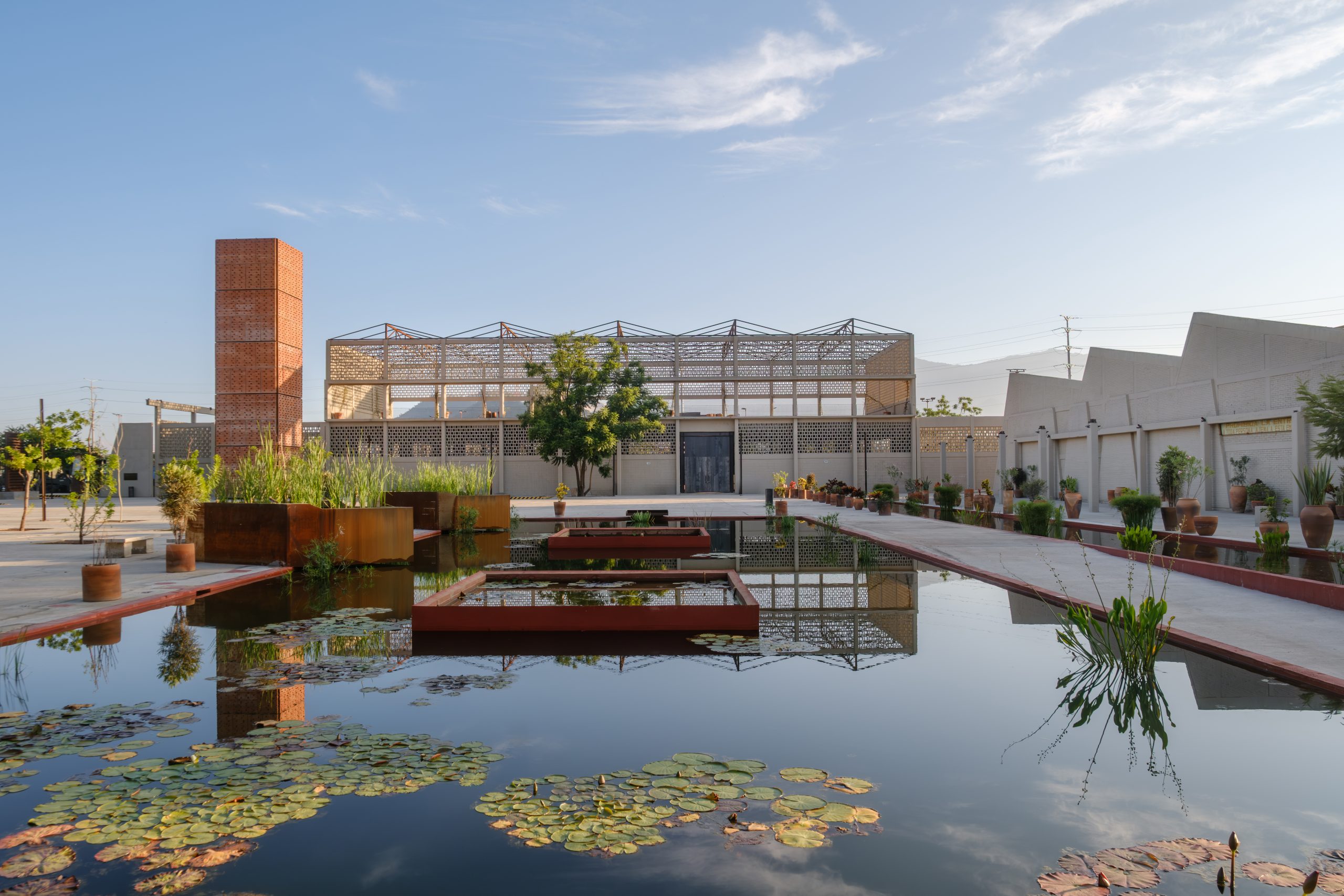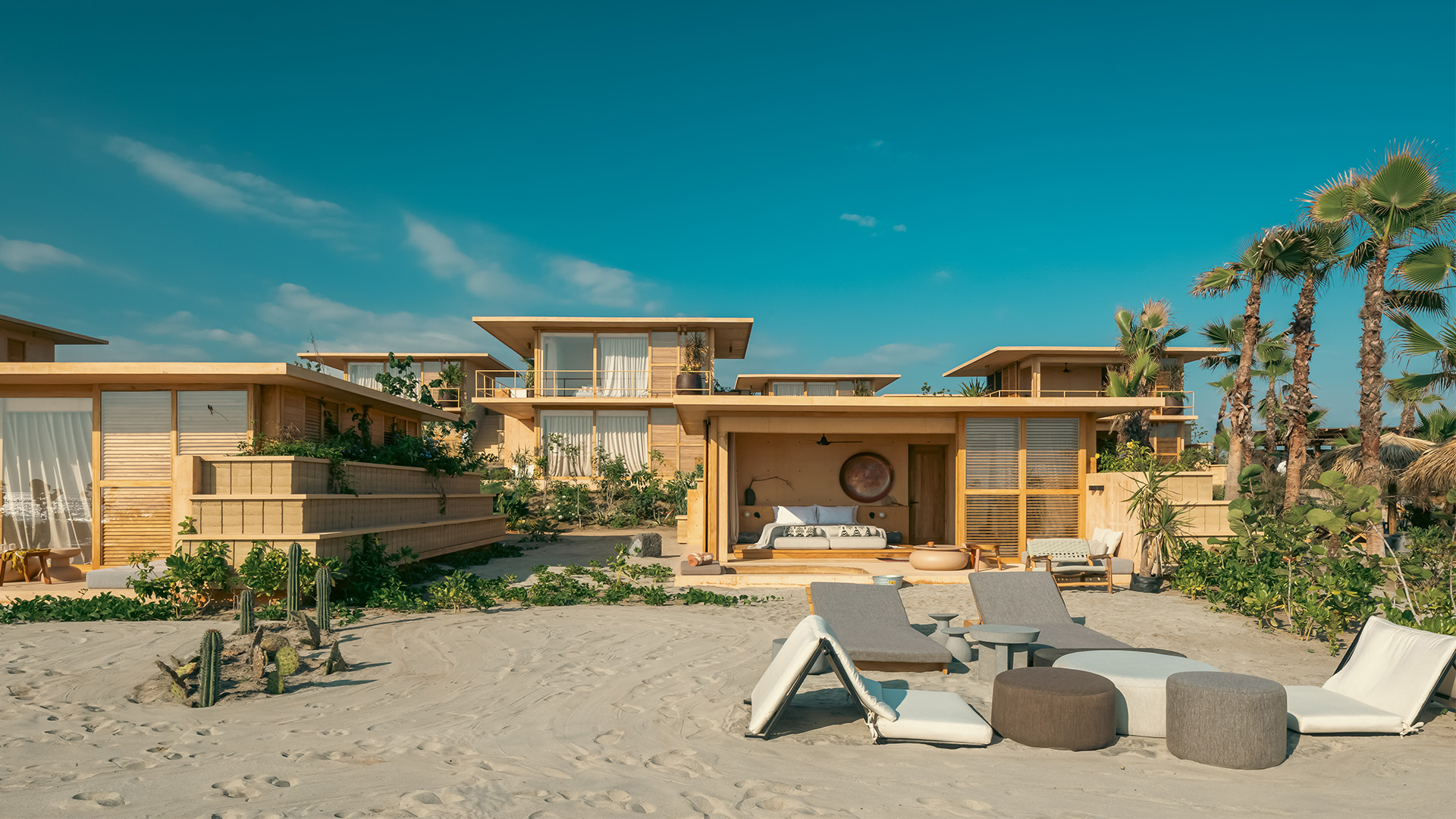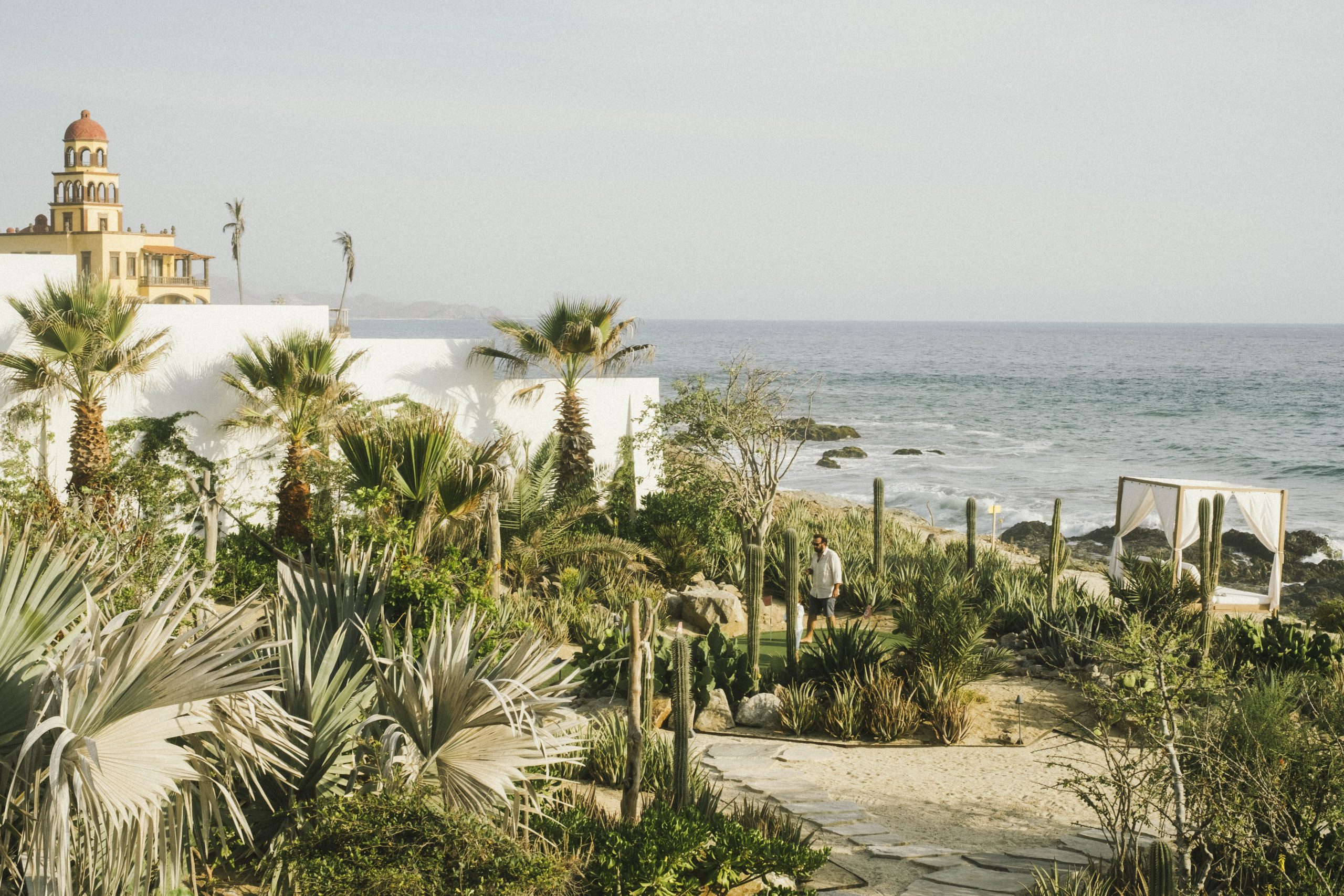Yaax Paisajismo invites us to discover the Río de los Remedios project: a successful regeneration story, an intervention that demonstrates the power of ecological restoration and brings color and nature back to a once-forgotten area.
Read More- No products in the cart.

Interventions
Discover the Loures Riverfront, an experience that connects the city with nature and celebrates life along the Tagus River, an article by Topiaris.
Loures Riverfront unfolds along the marshland ecosystem of the Tagus River, offering an 85-hectare greenway park, and providing a connection to the riverside, and featuring a 6,2km wooden boardwalk, completed with bird observation points, resting areas, fishing piers and shaded tunnels. It offers different opportunities for rest, leisure and sports, while allowing an immersion within the natural landscape.

- Vista mostrando estructura, ciclista y peatones / View showing structure, cyclist and pedestrians Fotografía / Photography: João Guimarães, Artur Carvalho
The initial premise was to complete the intermunicipal pedestrian and cycling continuity, connecting Lisbon to Vila Franca de Xira, and consolidate an important strategic plan that aims to implement a continuous route along the Tagus Riverfront in the Lisbon Metropolitan Area. At the same time, it was intended to encourage the connection to the Loures urban areas, isolated by roads and railway infrastructures. As a result, this route constitutes an important mobility infrastructure with a significant impact on the current daily commuter matrix, contributing to the reduction of CO2 emissions and positively affecting the lives of the surrounding communities.
The aim was to strengthen the connection with the urban areas of Loures, currently isolated by roads and railway infrastructures. This project has a positive impact on both mobility and the quality of life of the surrounding communities.

- Vista aérea / Aerial view
Fotografía / Photography: João Guimarães, Artur Carvalho
An analysis of the project area and its surroundings revealed a surprising landscape: a mosaic of natural ecosystems in the vicinity of a highly urbanized zone. Unexpectedly, just minutes away from densely populated neighbourhoods, one can find mudflats, salt marshes, native reed beds, all supporting a diverse array of flora and fauna habitats. Taking inspiration from the meandering drainage lines, the trail avoids straight lines in favour of a gentle, curving path, that allows observation of the habitats from different perspectives. Instead of providing a quick journey from point A to B, the project was designed to encourage a slower experience of the environment.

- Vista aérea / Aerial view
Fotografía / Photography: João Guimarães, Artur Carvalho
At km 2 from south, a special feature diverts from the path: The Tagus Circle. It forms a perfect loop and was created to enable the observation of the salt marsh in its different stages, showcasing its high ecological value, and highlighting its resilience and vulnerability. As we walk around its perimeter, we observe the sequence of distinct sub environments, each playing a vital role in the marsh’s ecosystem.
To preserve the marshes, the entire path consists of a raised wooden boardwalk, accommodating both pedestrian and bicycle traffic. Its variable elevation allows for the free flow of water, protecting this structure from flooding, while offering diverse experiences.

- Ejercitándose en el sendero / Exercising in the trail
Fotografía / Photography: João Guimarães, Artur Carvalho
Along the riverside trail, several new features have been added to enhance the journey. Observation and rest areas, slightly suspended off the main path, invite visitors to stop. Equipped with benches, bird observation counters, and a protective wooden structure that provides shade, these areas are the perfect place to stay and enjoy the place.

- Detalles de construcción / Construction details
Ilustración / Illustration: Topiaris
Interspersed between are shading tunnels, offering a cooler space for pedestrians and cyclists to slow down. Restored from the site’s industrial past, two concrete piers are now linked with the boardwalk, allowing access to the river, and welcoming local fishermen. This park would not only serve as a circulation and recreational route, but also as a platform for research, nature interpretation, and public education, raising public awareness for the importance of estuarine ecosystems, biodiversity conservation, and ocean management.

- Perspectiva mostrando vegetación y sendero / Perspective showing vegetation and trail
Ilustración / Illustration:Topiaris

- Vista mostrando vegetación y sendero / View showing vegetation and trail
Fotografía / Photography: João Guimarães, Artur Carvalho
Arquitectura del paisaje – Topiaris / Landscape architecture – Topiaris
Catarina Viana, Teresa Barão, Luis Ribeiro, Ana Lemos, Elsa Calhau, Rita Salgado , André Godinho, Henrique Mateus, Rita Lopes, Miguel Brito, Nuno Lecoq (Landscape Ecology consultant).
Fotografía / Photography
João Guimarães, Artur Carvalho.
Ingeniero Estructural / Structural Engineer – FTD / JETSJ
Pedro Delgado, Alexandre Pinto, Nuno Silva.
Señalización / Signage – DESENHARIA
Pedro Silva e Sousa.
Impacto Ambiental / Environmental Impact
Bioinsight.
Cliente / Client
Municipio de Loures. / Municipality of Loures.
Discover Oaxacan Spring Park Cho Ndobá: The Reinterpretation of an Urban Space, which, with a museum and an extensive network of ecological and recreational circuits, marks a milestone in Oaxaca’s urban regeneration. Designed by RootStudio in collaboration with LABORA, this new green lung represents a commitment to culture, community, and sustainability.
Read More
Discover Tonghai Park, which blends science and technology along the coastal edge of Yazhou Bay in China—an article by Chengdu MaiWei Landscape Architecture Studio.
Discover with Wish & Co, Productora, and The Book of WA the article on Kymaia, a Refuge of Sustainable Architecture and Conscious Design, a project that engages in dialogue with the sandy landscapes of the Oaxacan coast, integrating architecture and nature in harmony.
Step into The Cove – Conscious Gardening by the Pacific, a garden on the coast of Baja California Sur that shows us how it is possible to integrate with the sandy landscape through environmental sensitivity without giving up comfort or aesthetics, an article by Rodrigo Araiza Paisajismo.
In the growing community of Cerritos, Baja California Sur, rises The Cove, a beachfront residential project that has managed to adapt to its surroundings without sacrificing aesthetics. Cerritos, one of the most popular beaches on the Mexican Pacific, is experiencing rapid growth, and The Cove is part of this evolution, combining luxury with environmental sensitivity.
The first phase of the development included a tropical garden with extensive lawns, crinums, plumerias, and other exotic species. For the second stage, the developers sought a more sustainable approach and invited us to design a garden more integrated into the local landscape. The only requirement was to incorporate the use of treated greywater for irrigation. From there, we were given complete creative freedom to propose both the design and the plant palette.
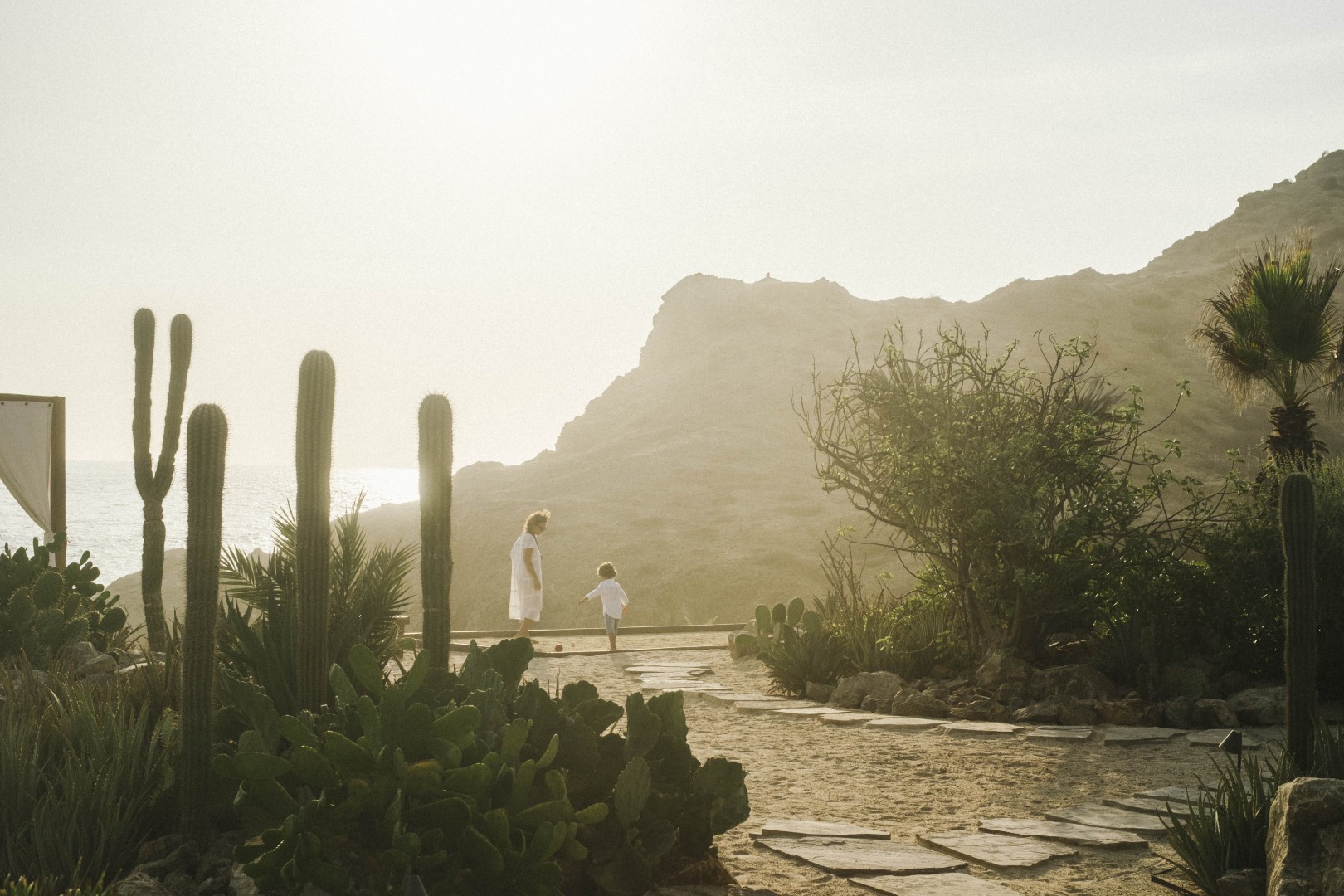
- Atardecer sobre cancha de bocce / Sunset over bocce court
Fotografía / Photography: Maria Emilia
The proposal was inspired by the arid, rocky character of Cerritos, integrating native flora with exotic species adapted to coastal conditions. Cardón cacti, lomboi, wild plums, and endemic prickly pears were combined with Bismarck palms, date palms, aloes, and scaevolas—a shrub that thrives remarkably well by the sea.
The proposal was inspired by the arid, rocky character of Cerritos, integrating native flora with exotic species adapted to coastal conditions.
The soil was one of the main challenges. Beneath a thin surface layer, we found almost continuous rock. To solve this, we brought in farm soil from the agricultural fields of Pescadero, mixing it with the local substrate. This allowed us to create mounds that facilitated root development while maintaining a natural aesthetic. The design balances clean lines, gentle curves, and sharp angles, achieving a harmonious integration between the natural and the architectural.
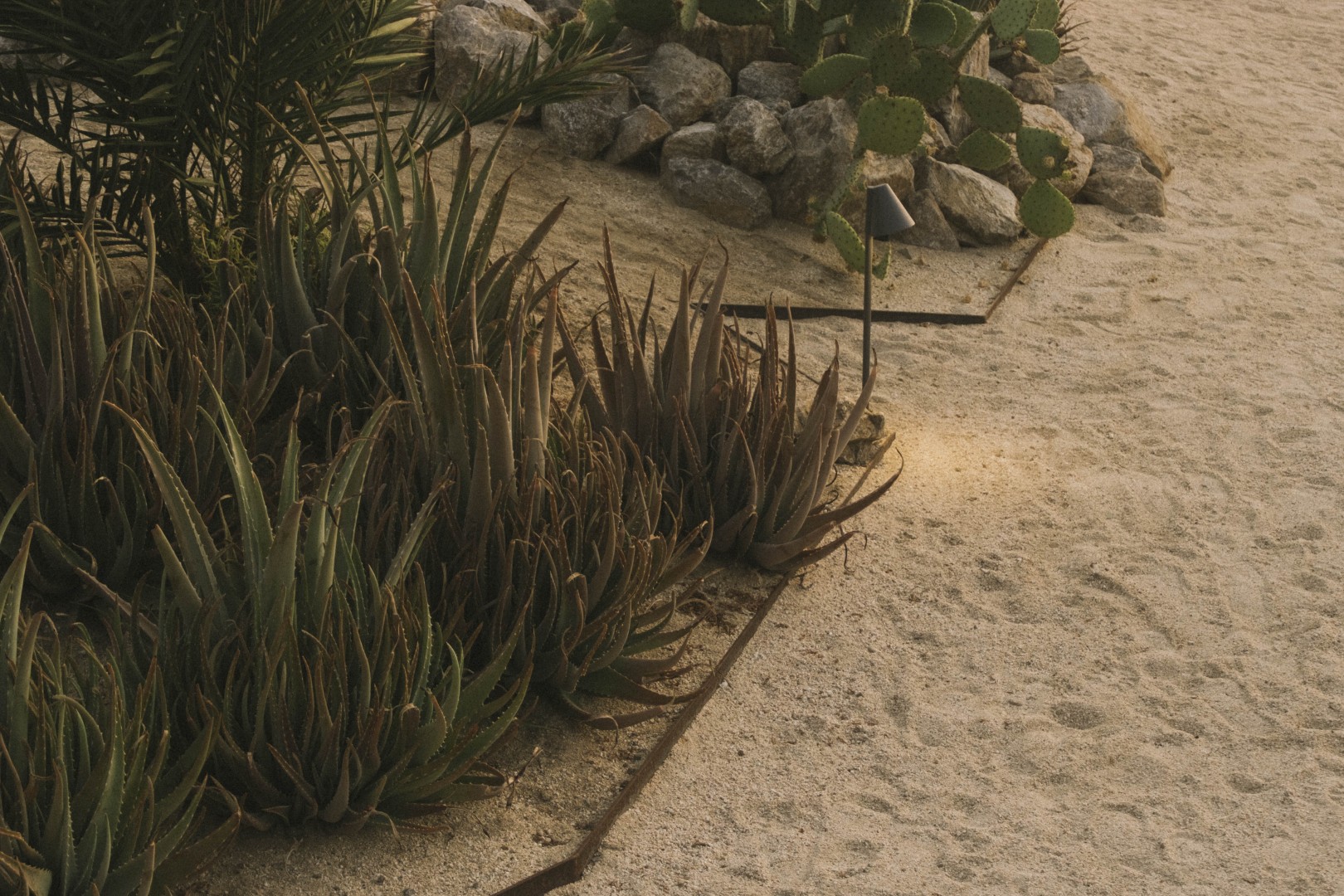
- Contención metálica de jardineras / Metal edging for planters
Fotografía / Photography: Maria Emilia
A second request from the client was to include a putting green and a small lounging area with sunbeds, as well as direct access to the virtually private beach. Although the garden covers no more than 700 m², all these elements were integrated without losing cohesion. Today, a year after planting, the garden has successfully matured. The summer heat and the automated irrigation system—adjusted by zones according to plant type—have enabled healthy growth and efficient water use.
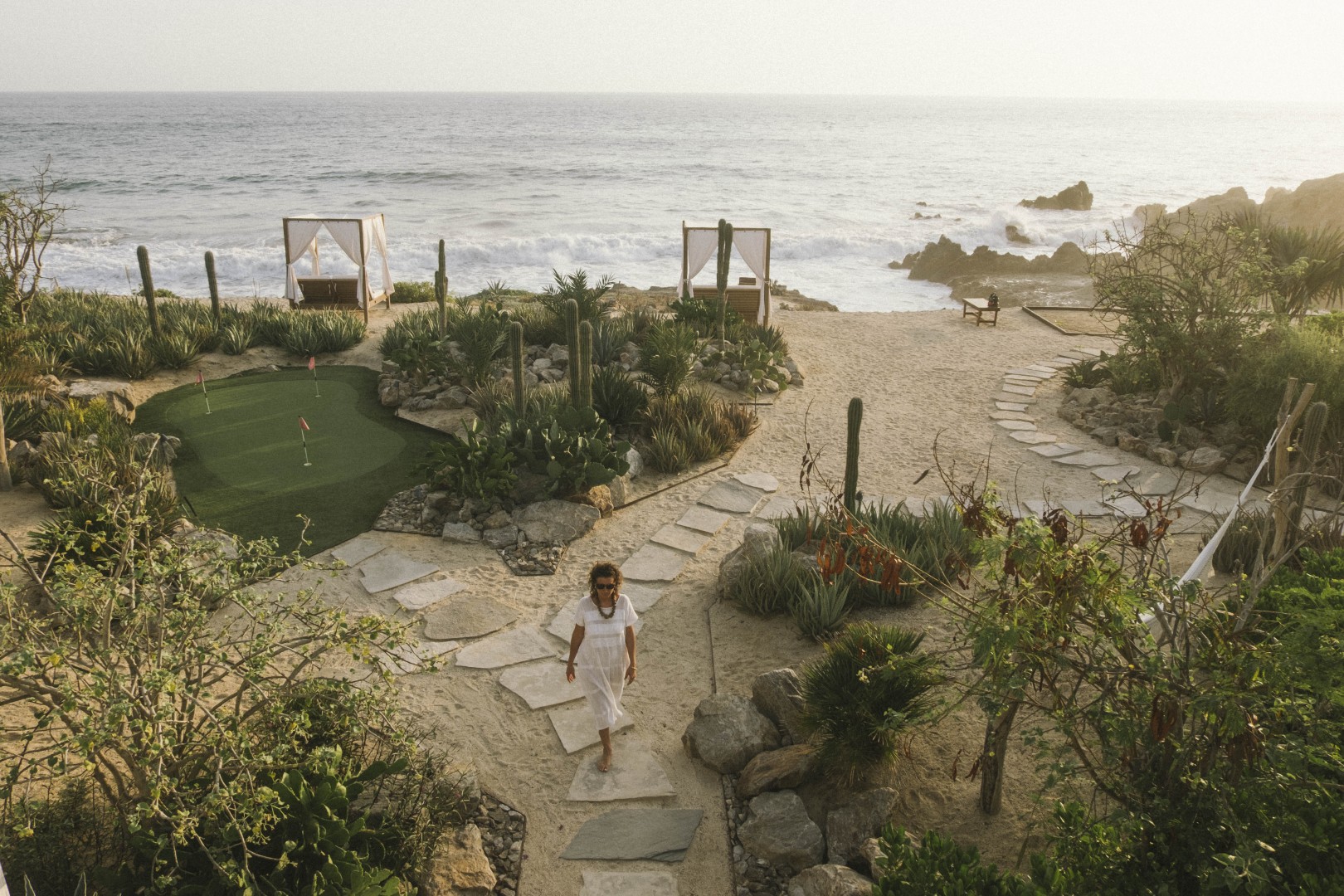
- Convergencia de arena-mar-golf / Convergence of sand, sea, golf
Fotografía / Photography: Maria Emilia
During a site walk, the spontaneous idea arose to add a pétanque court. The client recalled that his father loved this game—also known as bocce or bachi—and we decided to build it using leftover materials. With a view of the Pacific, it became one of the most special corners of the project.

- Vereda de piedras entre jardines / Stone path between gardens
Fotografía / Photography: Maria Emilia
Finally, subtle lighting was incorporated to ensure nighttime safety. Although it may appear intense in some areas, it meets the needs of residents, many of whom are older adults, and the terrain includes irregular surfaces such as flagstone.

- Infancias explorando senderos de paisaje / Children exploring landscape paths
Fotografía / Photography: Maria Emilia
This garden not only offers beauty and functionality, but also stands as an example of how landscape design can respect the natural environment without giving up comfort or aesthetics.
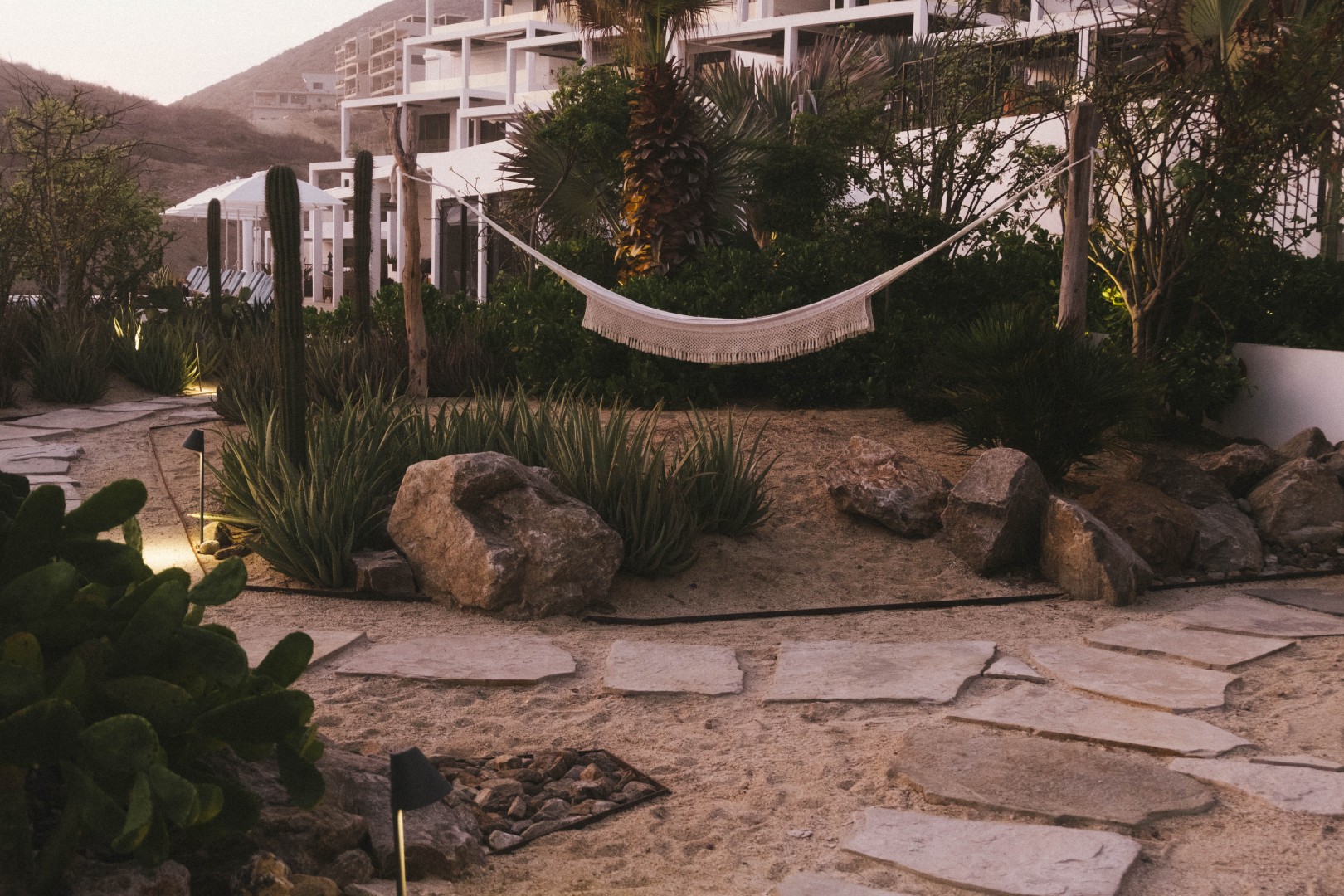
- Atardecer sobre jardin de hamaca / Sunset over hammock garden
Fotografía / Photography: Maria Emilia




